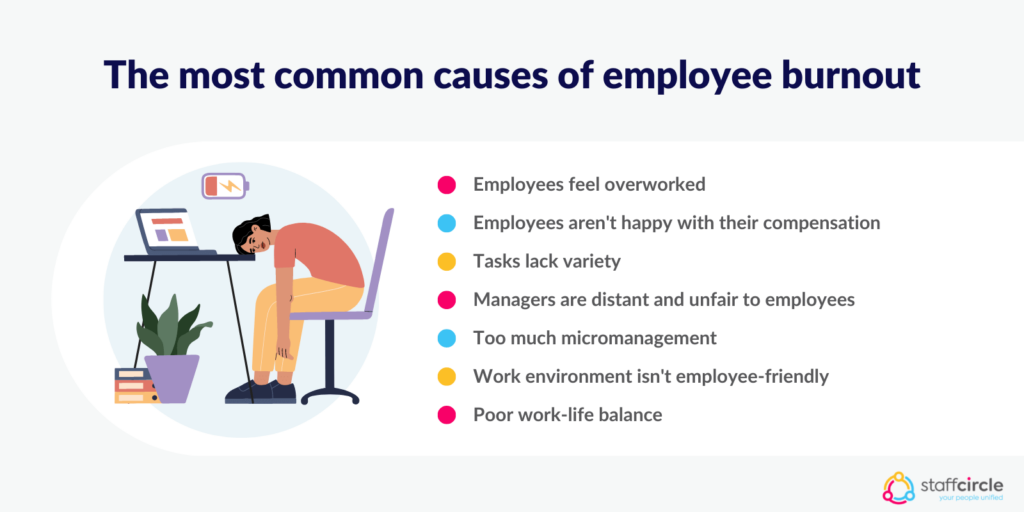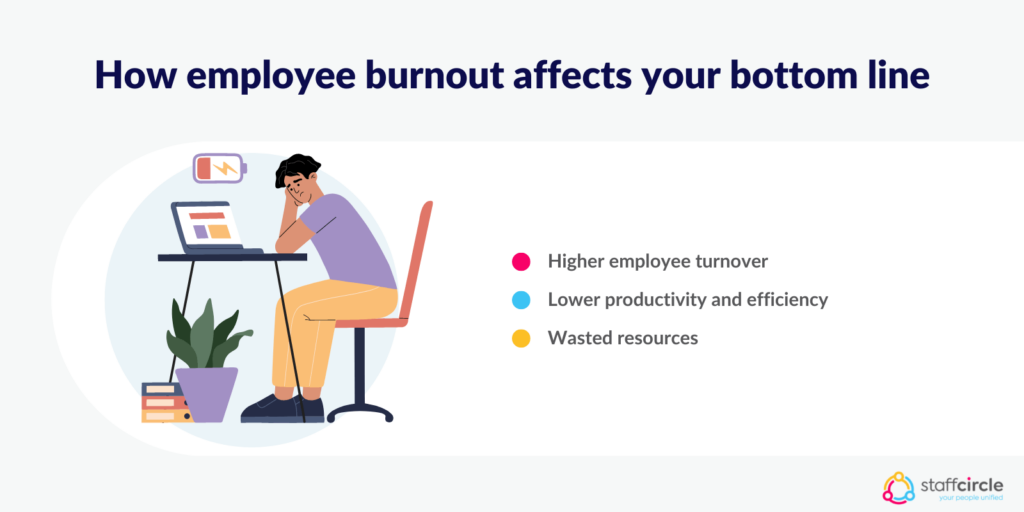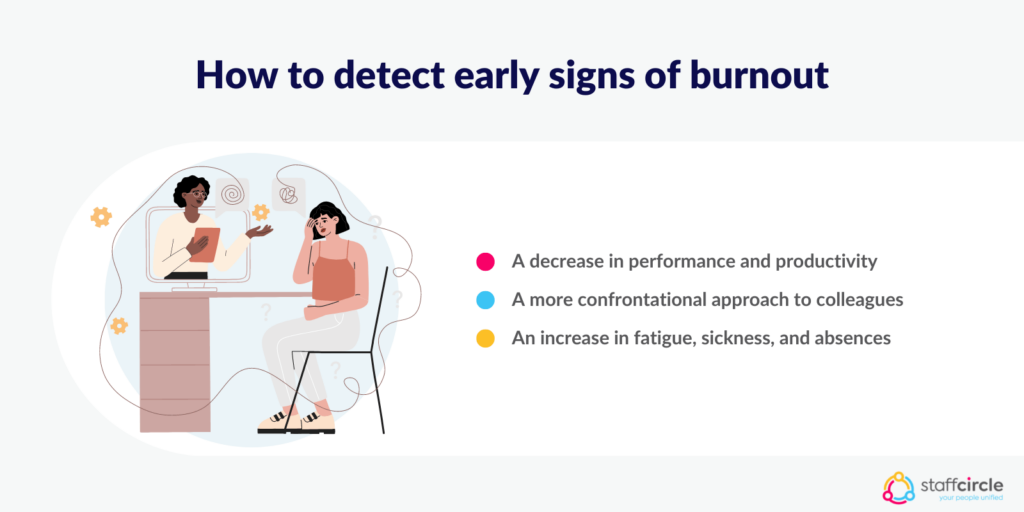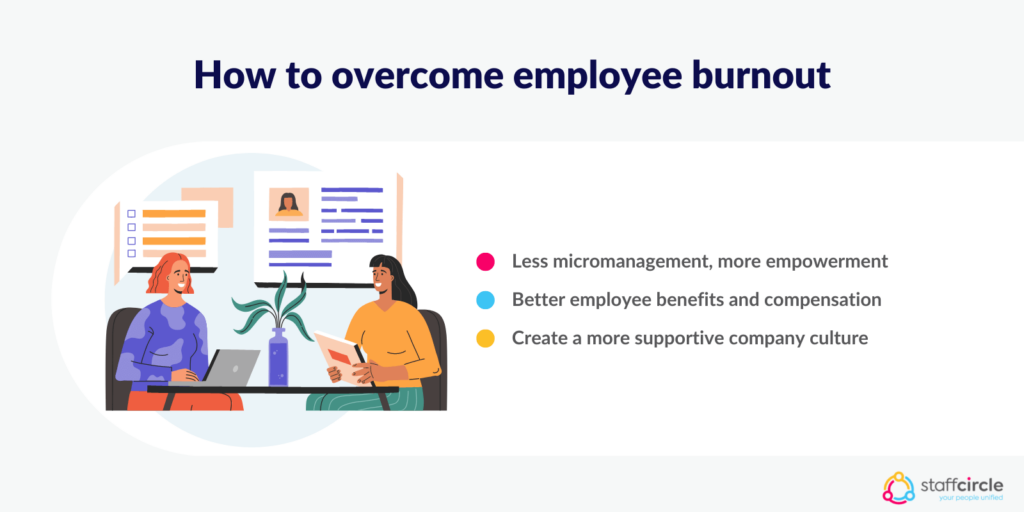What is employee burnout?
Employee burnout refers to the emotional and physical exhaustion felt when an employee is overworked or extremely dissatisfied with their work. Job burnout typically builds up over time and can occur under a variety of conditions.
It’s an issue that an increasing number of companies are dealing with. According to the American Psychological Association, burnout and stress are at all-time highs across a range of professions.
“Nearly 3 in 5 employees reported negative impacts of work-related stress, including lack of interest, motivation, or energy (26%) and lack of effort at work (19%). Meanwhile, 36% reported cognitive weariness, 32% reported emotional exhaustion, and an astounding 44% reported physical fatigue—a 38% increase since 2019.”
In this guide, we’ll examine the most common causes of workplace burnout, how it affects your bottom line, and the steps you can take to prevent employee burnout in your business.

What are the most common causes of employee burnout?
There is a range of factors that can lead an employee to experience burnout. Let’s take a look at some of the most common causes.
Employees feel overworked
One of the most common causes of job burnout is when employees feel overworked. That doesn’t necessarily mean that their team leaders and managers have unduly loaded them with more work than is reasonable to handle (although this can sometimes be the case).
Overwork can occur even when an employee is dealing with a moderate workload. It can be triggered by a range of other life factors that, when combined, induce stress and anxiety. In these situations, feelings of being overworked relate to deeper-rooted factors around health and well-being.
Employees aren’t happy with their compensation
When an employee puts in a lot of time and effort to get the job done, they do so with the level of compensation they expect to get in mind. If this compensation hasn’t been clearly stated in advance, or if the compensation they receive falls short of their expectations, the employee can experience burnout.

Tasks lack variety
Repetitive tasks can quickly lead to burnout, especially for employees who are extroverted and require varied stimulation to keep their interest high. When tasks lack variety – and need to be carried out over long periods of time – employees can soon feel the effects of burnout.
Managers are distant and unfair to employees
Awards and recognition programs in the workplace are essential for consistent engagement and productivity. When this positive feedback mechanism is removed, or when managers are distant and unfair to employees, enthusiasm drops and burnout can kick in.
There’s too much micromanagement
Micromanagement is one of the most common performance management issues, and a surefire way to increase an employee’s feeling of anxiety and create the conditions for burnout to thrive. When employees feel as if they have a manager constantly breathing down their neck, levels of unease increase and they aren’t capable of performing to the best of their abilities.
The work environment is not employee-friendly
If an employee feels as though they aren’t getting the support they need from colleagues and direct reports, burnout can eventually take over. When the work environment is more inclusive, staff can open up and speak freely about issues that might otherwise cause burnout to occur.
A poor work-life balance
A poor work-life balance in which employees feel as if they have little time for themselves is another core driver of job burnout. It can lead to employees sacrificing time with friends and family and finding a space where they can relax and unwind. If this situation goes on for too long, burnout is inevitable.
How employee burnout affects your bottom line
Workplace burnout doesn’t just affect the mental health and well-being of your employees, it can have a detrimental impact on your company’s bottom line.
Employee burnout can create:
Higher employee turnover
When burnout affects employees, it can have a serious impact on a company’s attrition rate, leading to higher employee turnover. When one employee experiences burnout, this can have a knock-on effect, increasing the risk of additional members of staff choosing to leave the company if the underlying issues aren’t addressed.

Lower productivity and efficiency
Burnout depletes energy levels, reduces focus, and eventually leads to a range of problems, from poor attendance to mistakes being made and deadlines missed. Productivity and efficiency take a big hit, with burnout capable of transforming the company’s star players into under-performers.
Wasted resources
The costs associated with burnout aren’t limited to the expense involved in dealing with high levels of turnover. Time and money invested in training and resources are also wasted if the employee fails to deliver the performance they were intended for. Likewise, mistakes made on the job cost additional resources for the company.
How can I detect early signs of workplace burnout in my employees?
If you’re concerned about employees experiencing burnout, look out for these early telltale signs so you can be proactive in offering support.
A decrease in performance and productivity
Perhaps the most obvious early warning sign of burnout, a reduction in productivity and performance can be easily measured with performance management tools. Managers and team leaders can monitor individual objectives and key results (OKRs) in real-time, highlighting any downward trend so they can take action.

A more confrontational approach to colleagues
A general downturn in an employee’s attitude and mannerisms is an indication burnout may be at play. Stress and anxiety lead people to be more reactive and otherwise lose their cool. They might also complain about others excessively and generally express themselves in a more argumentative fashion.
An increase in fatigue, sickness, and absences
Workers who feel burnout are more likely to turn up late at the office, take off more time for sickness, and exhibit signs of illness when present. As with poor performance, these contributing factors can all be tracked in real-time with performance management tools. Absence rates and any notes relating to medical conditions or personal issues can help flag potential burnout early on.
How can I overcome job burnout?
There are several techniques managers and business leaders can use to address employee job burnout. One way to accomplish this is to use real-time data from performance management software to identify trends such as poor performance, absence, and sickness rates early on.
Deloitte uses data to address employee burnout, a strategy you can apply to your business too. You can use performance management tools to prevent and address workplace burnout, monitoring an individual’s key performance indicators, one2one feedback, development objectives, and a range of other useful metrics.
Less micromanagement, more empowerment
The antidote to excessive micromanagement is adopting a management approach that seeks to empower individuals to hone their skills and become the best they can be. This can be achieved through transformational leadership, which unites employees behind a compelling vision of the future and encourages them to play to their core strengths.

Introduce better employee benefits and compensation
Poor or unfair treatment can be linked to burnout. If this is the case it’s worth considering the cost-benefit analysis of increasing benefits and compensation, compared to the potentially heavy costs faced through increased turnover.
Since healthy and productive employees are the most valuable commodity a business has, fair and equitable compensation is a good way to boost morale and reduce burnout.
Create a more supportive company culture
Chronic stress, anxiety, and other physical and mental health issues that surround the issue of workplace burnout often arise when employees feel disconnected from those around them. By using culture feedback mechanisms mental health support for all employees in how the company is defined, they feel connected to others and part of a shared vision of success.
Summary
With burnout costing companies an increasing amount, as well as taking an emotional and physical toll on those affected by it, it’s crucial to understand the conditions it can arise in and how to avoid it.
This guide should equip you with the necessary techniques to use real-time data to spot the early warning signs and create a company culture that gives employees the confidence to speak freely about their problems.





